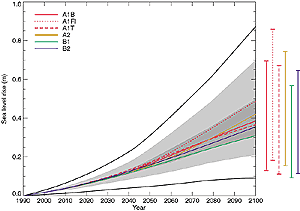11.5 Future Sea Level Changes
11.5.1 Global Average Sea Level Change 1990 to 2100

Figure 11.12: Global average sea level rise 1990 to 2100 for the SRES
scenarios. Thermal expansion and land ice changes were calculated using
a simple climate model calibrated separately for each of seven AOGCMs, and
contributions from changes in permafrost, the effect of sediment deposition
and the long-term adjustment of the ice sheets to past climate change were
added. Each of the six lines appearing in the key is the average of AOGCMs
for one of the six illustrative scenarios. The region in dark shading shows
the range of the average of AOGCMs for all 35 SRES scenarios. The region
in light shading shows the range of all AOGCMs for all 35 scenarios. The
region delimited by the outermost lines shows the range of all AOGCMs and
scenarios including uncertainty in land-ice changes, permafrost changes
and sediment deposition. Note that this range does not allow for uncertainty
relating to ice-dynamical changes in the West Antarctic ice sheet. See 11.5.4.3
for a full discussion. The bars show the range in 2100 of all AOGCMs for
the six illustrative scenarios |
Warrick et al. (1996) made projections of thermal expansion
and of loss of mass from glaciers and ice-sheets for the 21st century for the
IS92 scenarios using two alternative simple climate models. Since the SAR, time-dependent
experiments have been run with several AOGCMs (Chapter 9.1.2,
Table 9.1) following the IS92a scenario (Leggett
et al., 1992) for future concentrations of greenhouse gases, including the direct
effect of sulphate aerosols. In Section 11.5.1.1,
we use the AOGCM IS92a results to derive estimates of thermal expansion and
land ice melt, employing methods from the literature as described in Section
11.2, and we add contributions from thawing of permafrost, sediment deposition,
and the continuing adjustment of the ice sheets to climate changes since the
LGM. The choice of scenario is not the principal consideration; the main point
is that the AOGCMs all follow the same scenario, so the range of results reflects
the systematic uncertainty inherent in the modelling of sea level changes. The
use of IS92a also facilitates comparison with the result of Warrick et al. (1996).
To quantify the uncertainty resulting from the uncertainty in future emissions,
and to obtain results consistent with the global-average temperature change
projections of Section 9.3.3, in Section
11.5.1.2 we derive projections for thermal expansion and land ice melt for
the scenarios of the IPCC Special Report on Emissions Scenarios (SRES) (Nakic´enovic´
et al., 2000) (see also Box 9.1 in Chapter
9, Section 9.1). The results are given as sea level
change relative to 1990 in order to facilitate comparison with previous IPCC
reports, which used 1990 as their base date.
11.5.1.1 Projections for a single scenario based on a
range of AOGCMs
Thermal expansion
Over the hundred years 1990 to 2090, the AOGCM experiments for IS92a including
sulphate aerosols (GS experiments – see Chapter 9,
Table 9.1) show global-average sea level rise from
thermal expansion in the range 0.09 to 0.37 m (Figure
11.1, Table 11.11). There is an acceleration
through the 21st century; expansion for 2040 to 2090 is greater than for 1990
to 2040 by a factor of 1.4 to 2.1. Since the models experience the same forcing,
the differences in the thermal expansion derive from differences in the physical
behaviour of the models. Broadly speaking, the range of results reflects the
systematic uncertainty of modelling in three factors: the size of the surface
warming, the effectiveness of heat uptake by the ocean for a given warming (Gregory
and Mitchell, 1997) and the expansion resulting from a given heat uptake (Russell
et al., 2000). The separation of the first two factors parallels the distinction
made in Section 9.3.4.2 between the effects of climate
feedback and heat uptake on the rate of climate change. Since models differ
in regard to the second and third factors, experiments with a similar temperature
change do not necessarily have a similar thermal expansion, as the results demonstrate.
Continues on next page
|